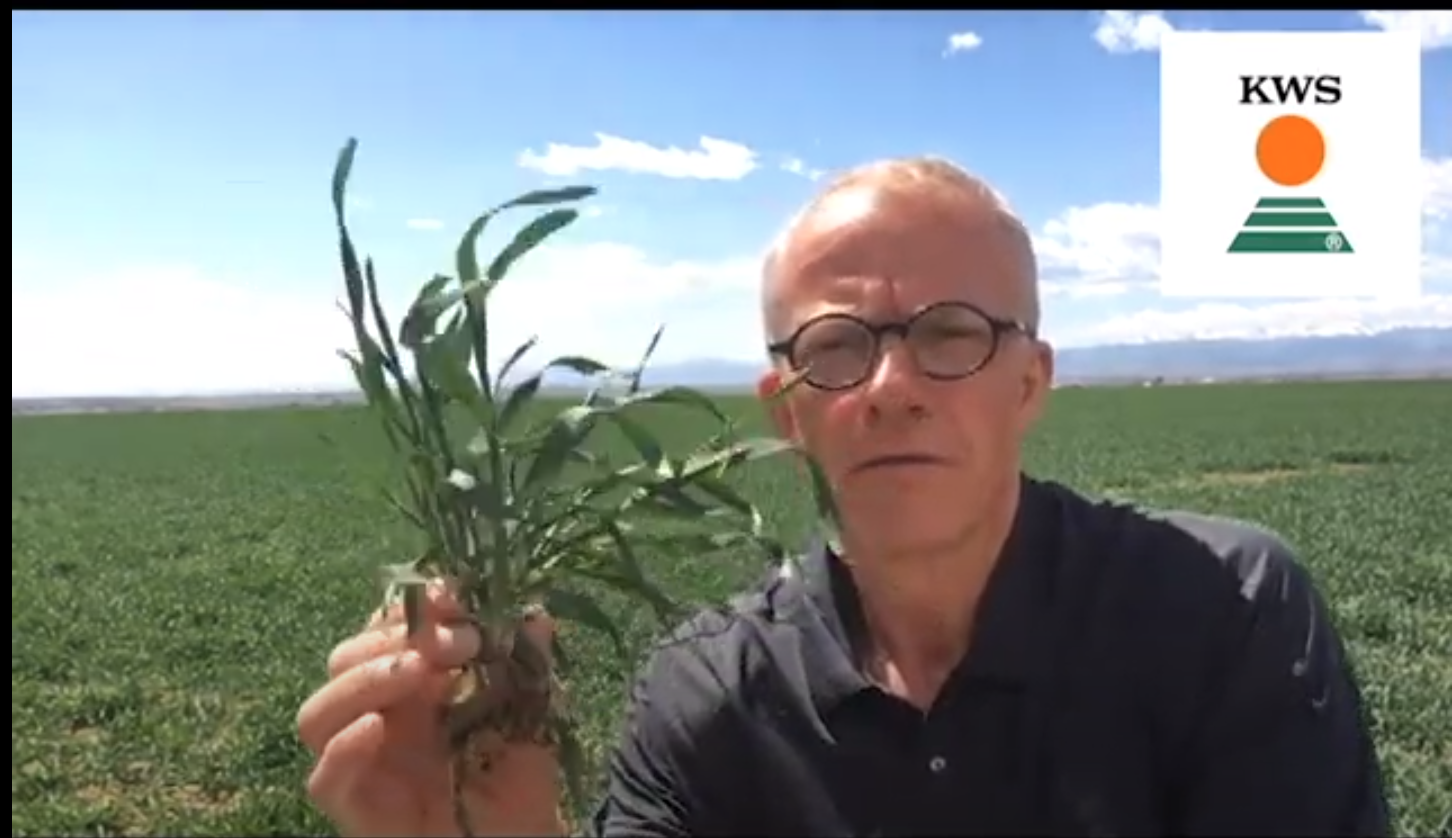Spring evaluation of your hybrid rye crop is critical to understand fertilization, yield potential, and replant options.
Warming temperatures are triggering green up in the hybrid rye crop, but is your crop worth keeping? And will your crop need additional fertilizer?
Hybrid rye is a vast improvement over the open-pollinated rye varieties often grown for cover crops. Hybrid rye grain and forage yields up to 40 percent greater than its conventional cousin, giving farmers more option for end-use markets and on-farm animal feed.
Spring is the time to assess hybrid rye regrowth to help determine yield and to evaluate if the crop needs to be terminated, according to Claus Nymand, Hybrid Rye Product Manager for KWS Cereals. In the three videos below, Claus shares how to perform the initial in-field inspection to check plant roots, to determine plant population, and to count plant tillers.
How to Perform an In-field Assessment of Hybrid Rye
- Build a Square-Foot Square. Claus suggests that growers build a simple square, one foot long on each side. It doesn’t need to be fancy—just tack some scrap wood together for this.
- Head into the Hybrid Rye Field. Bring a square-foot square and a shovel a square into the hybrid rye field.
- Examine Plant Roots. Dig up a sampling of hybrid rye plants and examine the roots. The roots are the first active part of the hybrid rye plant. The roots should be white and have soil sticking to them, indicating that a healthy root system is establishing.
- Perform Population Count. With your square-foot square, check plant population per square foot in a variety of locations in the field. Set down your square and simply count the plants within the square.
- Weed Count. Count the non-rye plants in your square-foot square.
- Tiller Count. Assess the number of tillers in the early-stage plants in order to decide fertilization levels.
By choosing many different good spots and “less-good” spots in the field, you can arrive at an average amount of plants per square foot. Ideally, you are trying for 17 hybrid rye plants per square foot, but anything above 10 plants per square foot, evenly distributed in the field, can still produce adequate yield.
Hybrid rye plant populations below 10 plants per square foot are too thin. Consider terminating the stand and planting something else. If left alone, even a thin stand will continue to produce small tillers that may flower later than the main crop, which can create uneven pollination and can increase the chance of ergot infection.
Fertilization of Hybrid Rye
Your fall-planted hybrid rye is a crop that grows in low temperatures, which means it actually started growing back in autumn. For an adequate crop, hybrid rye needs available nutrients at an early stage. KWS often recommends adding 20 to 40 pounds of nitrogen per acre in the autumn. Any spring-added nitrogen needs to be applied very early, because 90 to 95 percent of the nitrogen is taken up in the very early stage of plant development.
How much nitrogen should you apply? Claus suggests applying 1.2 pounds of nitrogen per expected bushels per acre. For example, if you expect to harvest 100 bushels per acre, you will need to apply 120 pound of nitrogen per acre in total. For that same 100-bushel target, you’ll need to apply about 25 pounds of phosphorus per acre; 40 to 50 pounds of potassium; and 25 pounds of sulfur.
High soil pH can make nutrient absorption difficult; phosphorous, for example. Above 7 pH, phosphorous availability is very low, which is also true for manganese. The plants will not be able to take up these nutrients from high pH soils. KWS recommends spraying manganese sulphate at about 4.5 to 9 pounds to the acre to help the early development of the hybrid rye crop.
Should You Use a Split Application of Nitrogen?
- Hybrid Rye for Grain. For grain growers with end markets in food milling or distilling, the short answer is no, because the protein level is less critical than yield.
- For Forage/Animal Feed. Increase the nitrogen slightly to 1.25 pounds per expected bushels per acre to ensure adequate protein levels.
Weed Management in Hybrid Rye
Claus shot the Weed Management video on April 8, 2020, in a field of hybrid rye that already is well developed. This early and vigorous growth competes well against most weeds, and hybrid rye produces some exudates in the root that can delay germination many weed seeds. This gives the hybrid rye a head-start to form a canopy that can shade out weed competition and to use the soil nutrition so it’s not available for a new flush of weeds.
Weed competition can happen, though, so your spring inspection should include a count of other plants that may compete with soil nutrients and moisture.
The bottom line is: it’s time to get into that hybrid rye field!
Hybrid rye vigor brings many benefits, including more seeds per head and more heads per plant, which results in higher grain yields and increased tons of forage. The KWS PollenPlus® system also increases ergot tolerance. Whether you’re a dairy or cattle producer seeking increased forage biomass, or a farmer seeking profit opportunities within the grain feeding, milling and brewing markets, hybrid rye is a low-input, high-return winter annual to consider adding to your rotation. Call Albert Lea Seed at (800) 352-5247 to learn more about our hybrid rye varieties.
